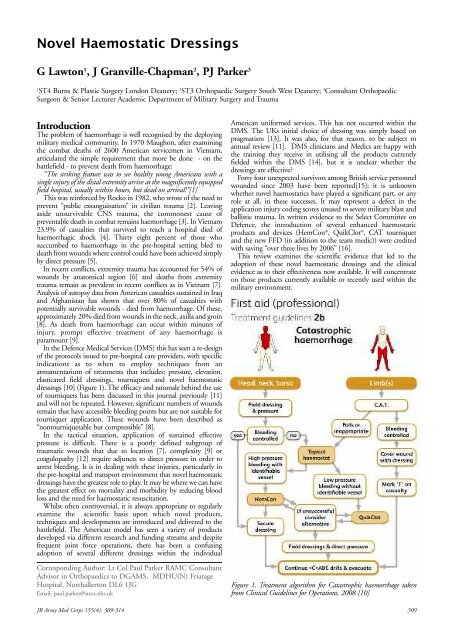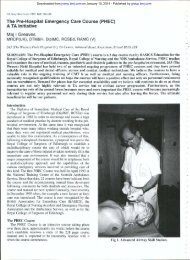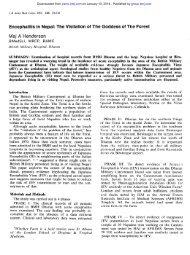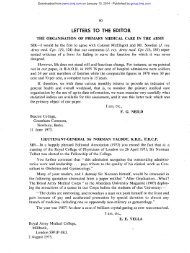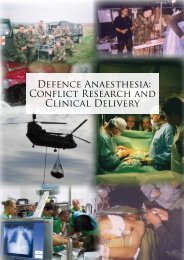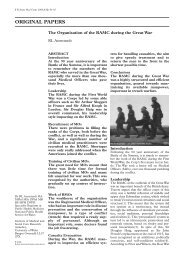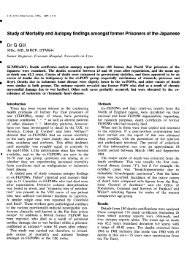Novel Haemostatic Dressings - Journal of the Royal Army Medical ...
Novel Haemostatic Dressings - Journal of the Royal Army Medical ...
Novel Haemostatic Dressings - Journal of the Royal Army Medical ...
Create successful ePaper yourself
Turn your PDF publications into a flip-book with our unique Google optimized e-Paper software.
<strong>Novel</strong> <strong>Haemostatic</strong> <strong>Dressings</strong><br />
G Lawton 1 , J Granville-Chapman 2 , PJ Parker 3<br />
1 ST4 Burns & Plastic Surgery London Deanery; 2 ST3 Orthopaedic Surgery South West Deanery; 3 Consultant Orthopaedic<br />
Surgeon & Senior Lecturer Academic Department <strong>of</strong> Military Surgery and Trauma<br />
Introduction<br />
The problem <strong>of</strong> haemorrhage is well recognised by <strong>the</strong> deploying<br />
military medical community. In 1970 Maughon, after examining<br />
<strong>the</strong> combat deaths <strong>of</strong> 2600 American servicemen in Vietnam,<br />
articulated <strong>the</strong> simple requirement that more be done - on <strong>the</strong><br />
battlefield - to prevent death from haemorrhage:<br />
“The striking feature was to see healthy young Americans with a<br />
single injury <strong>of</strong> <strong>the</strong> distal extremity arrive at <strong>the</strong> magnificently equipped<br />
field hospital, usually within hours, but dead on arrival!”[1]<br />
This was reinforced by Rocko in 1982, who wrote <strong>of</strong> <strong>the</strong> need to<br />
prevent “public exsanguination” in civilian trauma [2]. Leaving<br />
aside unsurvivable CNS trauma, <strong>the</strong> commonest cause <strong>of</strong><br />
preventable death in combat remains haemorrhage [3]. In Vietnam<br />
23.9% <strong>of</strong> casualties that survived to reach a hospital died <strong>of</strong><br />
haemorrhagic shock [4]. Thirty eight percent <strong>of</strong> those who<br />
succumbed to haemorrhage in <strong>the</strong> pre-hospital setting bled to<br />
death from wounds where control could have been achieved simply<br />
by direct pressure [5].<br />
In recent conflicts, extremity trauma has accounted for 54% <strong>of</strong><br />
wounds by anatomical region [6] and deaths from extremity<br />
trauma remain as prevalent in recent conflicts as in Vietnam [7].<br />
Analysis <strong>of</strong> autopsy data from American casualties sustained in Iraq<br />
and Afghanistan has shown that over 80% <strong>of</strong> casualties with<br />
potentially survivable wounds - died from haemorrhage. Of <strong>the</strong>se,<br />
approximately 20% died from wounds in <strong>the</strong> neck, axilla and groin<br />
[8]. As death from haemorrhage can occur within minutes <strong>of</strong><br />
injury, prompt effective treatment <strong>of</strong> any haemorrhage is<br />
paramount [9].<br />
In <strong>the</strong> Defence <strong>Medical</strong> Services (DMS) this has seen a re-design<br />
<strong>of</strong> <strong>the</strong> protocols issued to pre-hospital care providers, with specific<br />
indications as to when to employ techniques from an<br />
armamentarium <strong>of</strong> treatments that includes; pressure, elevation,<br />
elasticated field dressings, tourniquets and novel haemostatic<br />
dressings [10] (Figure 1). The efficacy and rationale behind <strong>the</strong> use<br />
<strong>of</strong> tourniquets has been discussed in this journal previously [11]<br />
and will not be repeated. However, significant numbers <strong>of</strong> wounds<br />
remain that have accessible bleeding points but are not suitable for<br />
tourniquet application. These wounds have been described as<br />
“nontourniquetable but compressible” [8].<br />
In <strong>the</strong> tactical situation, application <strong>of</strong> sustained effective<br />
pressure is difficult. There is a poorly defined subgroup <strong>of</strong><br />
traumatic wounds that due to location [7], complexity [9] or<br />
coagulopathy [12] require adjuncts to direct pressure in order to<br />
arrest bleeding. It is in dealing with <strong>the</strong>se injuries, particularly in<br />
<strong>the</strong> pre-hospital and transport environment that novel haemostatic<br />
dressings have <strong>the</strong> greatest role to play. It may be where we can have<br />
<strong>the</strong> greatest effect on mortality and morbidity by reducing blood<br />
loss and <strong>the</strong> need for haemostatic resuscitation.<br />
Whilst <strong>of</strong>ten controversial, it is always appropriate to regularly<br />
examine <strong>the</strong> scientific basis upon which novel products,<br />
techniques and developments are introduced and delivered to <strong>the</strong><br />
battlefield. The American model has seen a variety <strong>of</strong> products<br />
developed via different research and funding streams and despite<br />
frequent joint force operations, <strong>the</strong>re has been a confusing<br />
adoption <strong>of</strong> several different dressings within <strong>the</strong> individual<br />
Corresponding Author: Lt Col Paul Parker RAMC Consultant<br />
Advisor in Orthopaedics to DGAMS, MDHU(N) Friarage<br />
Hospital, Northallerton DL6 1JG<br />
Email: paul.parker@stees.nhs.uk<br />
American uniformed services. This has not occurred within <strong>the</strong><br />
DMS. The UKs initial choice <strong>of</strong> dressing was simply based on<br />
pragmatism [13]. It was also, for that reason, to be subject to<br />
annual review [11]. DMS clinicians and Medics are happy with<br />
<strong>the</strong> training <strong>the</strong>y receive in utilising all <strong>the</strong> products currently<br />
fielded within <strong>the</strong> DMS [14], but it is unclear whe<strong>the</strong>r <strong>the</strong><br />
dressings are effective?<br />
Forty four unexpected survivors among British service personnel<br />
wounded since 2003 have been reported[15]; it is unknown<br />
whe<strong>the</strong>r novel haemostatics have played a significant part, or any<br />
role at all, in <strong>the</strong>se successes. It may represent a defect in <strong>the</strong><br />
application injury coding scores unused to severe military blast and<br />
ballistic trauma. In written evidence to <strong>the</strong> Select Committee on<br />
Defence, <strong>the</strong> introduction <strong>of</strong> several enhanced haemostatic<br />
products and devices (HemCon ® , QuikClot ® , CAT tourniquet<br />
and <strong>the</strong> new FFD (in addition to <strong>the</strong> team medic)) were credited<br />
with saving “over three lives by 2006” [16].<br />
This review examines <strong>the</strong> scientific evidence that led to <strong>the</strong><br />
adoption <strong>of</strong> <strong>the</strong>se novel haemostatic dressings and <strong>the</strong> clinical<br />
evidence as to <strong>the</strong>ir effectiveness now available. It will concentrate<br />
on those products currently available or recently used within <strong>the</strong><br />
military environment.<br />
Figure 1. Treatment algorithm for Catastrophic haemorrhage taken<br />
from Clinical Guidelines for Operations, 2008 [10]<br />
JR <strong>Army</strong> Med Corps 155(4): 309-314 309
The Ideal <strong>Haemostatic</strong> Dressing<br />
The ideal haemostatic dressing should clearly be cheap, effective,<br />
simple to apply by ei<strong>the</strong>r <strong>the</strong> patient or provider, easy to remove,<br />
stable at extremes <strong>of</strong> temperature, safe to both patient and provider,<br />
and logistically acceptable. One American working group also<br />
defined a requirement to “stop large vessel arterial and venous<br />
bleeding within two minutes <strong>of</strong> application to a wound, in an actively<br />
bleeding environment through a pool <strong>of</strong> blood” [17]. It is difficult to<br />
attribute all <strong>of</strong> those qualities to any currently issued dressing.<br />
Current novel haemostatic dressings can be grouped as follows<br />
(Table 1).<br />
Class Product<br />
Factor<br />
Concentrators<br />
Active<br />
Agent<br />
Cost<br />
FDA<br />
approval<br />
Deployed<br />
QuikClot ® Zeolite £10 Yes Yes<br />
QuikClot<br />
ACSTMTM +<br />
TraumaDex TM Polysaccharide<br />
Hemosheres<br />
£16 Yes Yes<br />
£20 Yes<br />
WoundStat TM Smectite<br />
mineral clay<br />
£30 Yes Withdrawn<br />
Mucoadhesive<br />
Agents Hemcon ® Chitosan £66 Yes Yes<br />
Procoagulant<br />
Supplementors<br />
Celox TM £20 Yes<br />
TraumaStat TM £66 Yes<br />
RDH<br />
Poly-N-Acetyl<br />
Glucosamine<br />
N/A Yes<br />
mRDH £250 Yes<br />
Super QR<br />
Dry Fibrin<br />
Sealant<br />
TachoComb<br />
H ®<br />
K Fe Oxyacid<br />
Salt<br />
Hydrophilic<br />
polymer<br />
Fibrinogen<br />
Thrombin<br />
C++ FXIII<br />
Collagen<br />
Thrombin<br />
Fibrinogen<br />
£10 No<br />
>£550 No Yes (1 pt)<br />
N/A No<br />
CombatGauze Kaolin £30 Yes Yes<br />
Table 1 Currently available novel haemostactics and <strong>the</strong>ir characteristics<br />
Factor Concentrators<br />
These include products such as QuikClot ® , QuikClot ACSTM +,<br />
WoundStat TM , TraumaDex TM , and Self-Expanding Hemostatic<br />
Polymer (SEHP).<br />
QuikClot®<br />
QuikClot ® (Z-Medica, Wallingford, CT) is a granular preparation<br />
composed <strong>of</strong> sodium, silicon, aluminium and magnesium oxides<br />
with small amounts <strong>of</strong> quartz [18] that works by adsorbing <strong>the</strong><br />
water component <strong>of</strong> blood in an exo<strong>the</strong>rmic reaction, <strong>the</strong>reby<br />
concentrating clotting factors, it also supplies Ca2+ ions and<br />
activates platelets as fur<strong>the</strong>r adjuncts to coagulation [19]. The exact<br />
mode <strong>of</strong> action <strong>of</strong> QuikClot ® has never been proven<br />
experimentally [20]. In 2002 it was approved by <strong>the</strong> Federal Drugs<br />
Administration (FDA) “as an external temporary traumatic wound<br />
treatment to achieve hemostasis for moderate to severe bleeding” [21].<br />
In 2003 both <strong>the</strong> United States Navy and Marine Corps adopted<br />
QuikClot ® . In <strong>the</strong> planning for Operation Iraqi Freedom <strong>the</strong><br />
intent was to issue it to every Marine engaged in combat<br />
operations. This was in part due to its performance in an Office <strong>of</strong><br />
Navy Research grant funded comparative study, utilising a swine<br />
complex groin wound model <strong>of</strong> haemorrhage to examine <strong>the</strong><br />
effectiveness <strong>of</strong> QuikClot ® against o<strong>the</strong>r commercially available<br />
dressings [22]. This model involved transecting <strong>the</strong> femoral<br />
vasculature and s<strong>of</strong>t-tissues <strong>of</strong> a pig at <strong>the</strong> level <strong>of</strong> <strong>the</strong> inguinal<br />
ligament. After a five-minute delay <strong>the</strong> dressing in question and<br />
direct pressure were applied. After a fur<strong>the</strong>r 30 minutes 1000mls <strong>of</strong><br />
normal saline 0.9% was administered over a thirty-minute period.<br />
Mortality was 83% without treatment, 33.4% with standard gauze<br />
and 0% with QuikClot ® [22].<br />
When QuikClot ® was compared against HemCon ® , using <strong>the</strong><br />
same injury model but a different resuscitation protocol (6%<br />
Hetastarch in 500mls 0.9% normal saline given over 30 minutes,<br />
begun 15 minutes following injury) it outperformed its rival<br />
reducing quoted mortality to 0% compared with 28.6% for<br />
HemCon ® [23]. The performance <strong>of</strong> HemCon ® was noted as<br />
providing ei<strong>the</strong>r complete arrest <strong>of</strong> haemorrhage (5/7 animals) or<br />
being completely ineffective (2/7 animals). This was postulated to<br />
be related to ‘manufacturing issues’ and variability in <strong>the</strong> quality <strong>of</strong><br />
<strong>the</strong> HemCon ® end product.<br />
The main criticisms <strong>of</strong> QuikClot ® have involved <strong>the</strong> exo<strong>the</strong>rmic<br />
nature <strong>of</strong> <strong>the</strong> reaction <strong>of</strong> <strong>the</strong> zeolite. When added to water alone<br />
temperatures <strong>of</strong> 100 oC are produced [24]. Information regarding its<br />
use is ra<strong>the</strong>r mischievously included on <strong>the</strong> US <strong>Army</strong> <strong>Medical</strong><br />
Material Agency website under “Hot Topics.” [25]. In his 2003<br />
study Alam recorded maximum temperatures <strong>of</strong> 42-44 o C, and <strong>the</strong><br />
following year zeolite preparations achieved wound temperatures <strong>of</strong><br />
51-57 o C [22, 23]. O<strong>the</strong>r investigators have reported wound<br />
temperatures <strong>of</strong> 58 o C using ei<strong>the</strong>r <strong>the</strong> original granules or <strong>the</strong> ACS<br />
preparation [30]. Applied to a 6mm swine femoral arteriotomy<br />
wound through a pool <strong>of</strong> blood, wound temperatures <strong>of</strong> 70.8 o C<br />
have been recorded [27].<br />
When United States Air Force (USAF) investigators examined<br />
<strong>the</strong> exo<strong>the</strong>rmic nature <strong>of</strong> <strong>the</strong> reaction in a swine model <strong>of</strong> tissue<br />
injury <strong>the</strong>y demonstrated full thickness burns at <strong>the</strong> edges <strong>of</strong> <strong>the</strong><br />
groin wounds. Even greater increases in temperature (over 100 o C<br />
at <strong>the</strong> wound edge) were reported. It is unclear what exact deep<br />
wound temperatures were recorded when QuikClot ® was used as<br />
per <strong>the</strong> manufacturers instructions [28].<br />
Criticisms <strong>of</strong> <strong>the</strong> granular nature <strong>of</strong> <strong>the</strong> agent and <strong>the</strong> difficulty<br />
in applying it to an actively bleeding wound [29] has seen <strong>the</strong><br />
product converted into a “teabag” with granules placed into a<br />
meshed bag (QuikClot ® Advanced Clotting Sponge (ACS)) and<br />
now QuikClot ® beads within a bag with interior baffles creating<br />
four compartments (QuikClot ACS+ TM ). The beads are zeolite<br />
with a larger diameter (1.7-2.4 mm) than <strong>the</strong> granules (0.4-0.8<br />
mm) and are equally as effective in a swine groin injury model with<br />
<strong>the</strong> same maximum wound temperatures achieved [30]. The<br />
bagged preparations are said to be easier to remove at <strong>the</strong> definitive<br />
care facility and ACS+ has a silicon rod within <strong>the</strong> bag for ease <strong>of</strong><br />
location on wound radiographs [31].<br />
Clinical reports are now being published regarding <strong>the</strong> use <strong>of</strong><br />
QuikClot ® in military and civilian trauma settings. The only case<br />
series published, examined <strong>the</strong> use <strong>of</strong> QuikClot ® in 103 cases<br />
ranging from <strong>the</strong> US military in Iraq to first responders and trauma<br />
surgeons in a civilian EMS [32]. It is a retrospective, nonconsecutive<br />
observational study. The data was collected by<br />
completion <strong>of</strong> “self reporting survey sheets” with three-quarters <strong>of</strong><br />
those completing <strong>the</strong> sheets being interviewed by <strong>the</strong> lead<br />
investigator. A representative example <strong>of</strong> a completed sheet is at<br />
figure 2.<br />
Analysis <strong>of</strong> all 103 cases demonstrated an overall efficacy rate <strong>of</strong><br />
92%. Of <strong>the</strong> eight failures, five occurred in non-body cavity<br />
wounds making QuikClot ® 94% effective in achieving haemostasis<br />
on extremity and superficial thoraco-abdominal wounds, in those<br />
cases included in this study. Only medical <strong>of</strong>ficers and trauma<br />
surgeons reported failures <strong>of</strong> <strong>the</strong> product to achieve haemostasis.<br />
This was thought to be due to <strong>the</strong> moribund condition <strong>of</strong> <strong>the</strong><br />
patient or <strong>the</strong> inability to place QuikClot ® adjacent to <strong>the</strong> site <strong>of</strong><br />
haemorrhage. There were three cases <strong>of</strong> burn injury attributed to<br />
<strong>the</strong> use <strong>of</strong> QuikClot ® and one <strong>of</strong> <strong>the</strong>se required formal skin<br />
grafting.<br />
Surprisingly for a product never intended for intra-corporeal use<br />
<strong>the</strong> study documented 20 such episodes, one <strong>of</strong> which had been<br />
previously reported in <strong>the</strong> literature [33]. In each instance<br />
application <strong>of</strong> QuikClot ® was deemed a “last resort” measure but<br />
was effective in 18/20 cases with only one serious complication.<br />
The complication manifested itself two months following<br />
application <strong>of</strong> QuikClot ® to a ballistic injury involving <strong>the</strong> sacroiliac<br />
joint. Ureteric obstruction occurred secondary to scarring<br />
310 JR <strong>Army</strong> Med Corps 155(4): 309-314
ei<strong>the</strong>r completely effective (5/7 animals) or ineffective, this was<br />
thought to be due to quality assurance issues [23]. These were<br />
addressed and <strong>the</strong> new dressings were tested at <strong>the</strong> USAISR<br />
“expeditiously (in one day)” [51] before being declared suitable for<br />
utilization in current <strong>the</strong>atres <strong>of</strong> operations.<br />
In 2008 HemCon ® was again examined in a swine femoral<br />
vasculature complete transection model. It performed no better<br />
than standard gauze with respect to mortality [52]. In this study<br />
HemCon ® was applied after 30 seconds <strong>of</strong> uncontrolled<br />
haemorrhage. Direct manual pressure was maintained for five<br />
minutes through an abdominal pack and <strong>the</strong> wound examined.<br />
Failure to achieve haemostasis was defined as “blood pooling<br />
outside <strong>the</strong> wound.” Aggressive fluid resuscitation commenced on<br />
application <strong>of</strong> <strong>the</strong> dressing, with lactated Ringer’s solution delivered<br />
at 165ml/min in an attempt to maintain mean arterial blood<br />
pressure (MABP) at pre-injury levels. During <strong>the</strong> 120-minute<br />
study period <strong>the</strong>re were 8/10 dressing failures in <strong>the</strong> HemCon ®<br />
group with three deaths. Standard gauze dressings resulted in 5/10<br />
dressing failures with one death.<br />
The significant differences between <strong>the</strong> Alam 2004 [23] and<br />
Englehart 2008 [52] studies were <strong>the</strong> duration <strong>of</strong> uncontrolled<br />
haemorrhage and <strong>the</strong> resuscitation protocols. The uncontrolled<br />
haemorrhage lasted three minutes in 2004 and 30 seconds in 2008,<br />
leading to lower MABPs on application <strong>of</strong> <strong>the</strong> HemCon ® in 2004.<br />
The differing resuscitation strategies saw no animal improve<br />
MABP in <strong>the</strong> initial study whereas <strong>the</strong> high volume crystalloid<br />
strategy in 2008 saw MABP rally <strong>the</strong>n fall steadily with failure <strong>of</strong><br />
haemostasis and fur<strong>the</strong>r bleeding. Therefore we see how HemCon ®<br />
performed better in <strong>the</strong> model with lower MABP on application<br />
and “hypotensive” style resuscitation. Although in both studies it<br />
did not statistically outperform <strong>the</strong> standard dressing control.<br />
In high pressure uncontrolled models <strong>of</strong> arterial haemorrhage<br />
such as swine 4.4 mm punch biopsy <strong>of</strong> <strong>the</strong> aorta, HemCon ® has<br />
been unable to sustain haemostasis despite initial control <strong>of</strong><br />
bleeding in 5/7 test animals [53]. With a 6mm femoral artery<br />
punch biopsy injury HemCon ® has been unable to influence<br />
mortality and although able, once again, to gain control <strong>of</strong> <strong>the</strong><br />
initial haemorrhage in 6/10 animals was able to maintain<br />
haemostasis in only 1/10 pigs for <strong>the</strong> 180 minute study period.<br />
Notably, failed to control <strong>the</strong> initial haemorrhage in 0/6 and was<br />
<strong>the</strong>refore excluded from <strong>the</strong> remainder <strong>of</strong> <strong>the</strong> study [38].<br />
Chit<strong>of</strong>lex<br />
Early user feedback criticised <strong>the</strong> wafer texture <strong>of</strong> <strong>the</strong> original<br />
HemCon ® dressing and its inability to be placed into small wounds<br />
or cavities, requiring it to be cut into pieces [42]. This resulted in<br />
<strong>the</strong> development <strong>of</strong> ChitoFlex. ChitoFlex is a chitosan dressing in<br />
a more flexible format with two active sides specifically to be<br />
delivered into wound tracts perhaps reflecting <strong>the</strong> practise <strong>of</strong><br />
combat medics folding HemCon ® on itself to create an ad hoc twosided<br />
product [54]. When compared with standard gauze and<br />
TraumaStat TM in a swine groin wound model <strong>the</strong>re was no<br />
difference between ChitoFlex and standard gauze, although<br />
advocates <strong>of</strong> ChitoFlex would criticise that it was not used as <strong>the</strong><br />
manufacturers advised.<br />
Celox TM<br />
CeloxTM (SAM <strong>Medical</strong> Products, Newport OR) is a chitosan based<br />
dressing in a granular format. When compared against HemCon ® ,<br />
QuikClot ® and standard gauze in a swine groin model <strong>of</strong> fatal<br />
haemorrhage as described by Alam et al, CeloxTM performed well<br />
with 12/12 animals surviving. There was no statistically<br />
demonstrable difference between <strong>the</strong> remaining dressings in terms<br />
<strong>of</strong> survival. However, QuikClot ® saved 11/12 and <strong>the</strong>refore <strong>the</strong><br />
failure to achieve statistical significance is due to failure in a single<br />
animal. Post-mortem inspection <strong>of</strong> this specimen revealed that <strong>the</strong><br />
QuikClot ® had not reached <strong>the</strong> vessels and had “migrated to an<br />
adjacent s<strong>of</strong>t tissue void” [55].<br />
There are two clinical case series examining <strong>the</strong> use <strong>of</strong> HemCon ®<br />
in military [42] and civilian [56] trauma systems. Wedmore<br />
reported <strong>the</strong> early military experience based upon <strong>the</strong> verbal reports<br />
from Special Forces medical providers in far forward positions. 64<br />
case reports were deemed suitable and <strong>the</strong> dressing was successful<br />
in 97% <strong>of</strong> <strong>the</strong>se cases. In two-thirds <strong>of</strong> episodes standard gauze<br />
dressings had been unsuccessful prior to <strong>the</strong> application <strong>of</strong><br />
HemCon ® . There were no reported adverse effects attributable to<br />
<strong>the</strong> dressings. [42]<br />
Civilian emergency medical providers have had a less successful<br />
but still positive experience with HemCon ® . A retrospective<br />
questionnaire based survey <strong>of</strong> <strong>the</strong> experience <strong>of</strong> Portland<br />
firefighters, 60% <strong>of</strong> whom were also trained as paramedics is<br />
presented. Over a 15-month period 37 episodes were recorded <strong>of</strong><br />
which 34 had sufficient data recorded to be included in <strong>the</strong> study.<br />
HemCon ® controlled haemorrhage in 79% <strong>of</strong> cases. In 25/34<br />
direct pressure with gauze and adjuncts such as elevation had failed<br />
to stop <strong>the</strong> bleeding. The bleeding was ascertained by <strong>the</strong> acute<br />
responder as being venous (13/34), arterial (12/34) or unknown<br />
(9/34). Review <strong>of</strong> <strong>the</strong> cases where HemCon ® had proven ineffective<br />
concluded that user error had contributed to <strong>the</strong> failure <strong>of</strong><br />
haemostasis (6/7 cases). Again <strong>the</strong>re were no reported adverse<br />
effects [56].<br />
TraumaStat TM<br />
TraumaStat TM (Ore-Medix, Lebanon, OR) is a sponge like dressing<br />
composed <strong>of</strong> silica fibres coated in chitosan. Polyethylene<br />
maintains <strong>the</strong> porous nature <strong>of</strong> <strong>the</strong> sponge that toge<strong>the</strong>r with <strong>the</strong><br />
number <strong>of</strong> silica fibres gives each sponge a vast surface area<br />
(110m 2 /g) [52]. One Oregon based group has utilised a swine<br />
groin wound model to examine its effectiveness against HemCon ®<br />
and ChitoFlex in two separate studies concluding that<br />
TraumaStat TM was more effective [54].<br />
Procoagulant Supplementors<br />
Combat Gauze TM<br />
Combat GauzeTM (Z-Medica, Wallingford, CT) sees Kaolin<br />
bonded to a polyester/rayon gauze that can be stuffed into cavity<br />
wounds or applied onto open wounds like a standard dressing.<br />
Kaolin is a layered clay that has as its active ingredient aluminium<br />
silicate. It has historically been utilised to monitor <strong>the</strong> effects <strong>of</strong><br />
heparin <strong>the</strong>rapy, as it is a potent activator <strong>of</strong> <strong>the</strong> intrinsic clotting<br />
system [57]. It has been shown to be as effective as QuikClot ® in<br />
causing in vitro porcine blood to coagulate without any excess heat<br />
being generated [24]. Z-Medica is currently <strong>the</strong> recipient from <strong>the</strong><br />
United States Department <strong>of</strong> Defense <strong>of</strong> a US$ 3.2 million grant<br />
for ongoing trials.<br />
Live animal modeling has seen a kaolin coated gauze stop<br />
haemorrhage in a swine model <strong>of</strong> femoral artery and vein<br />
transection as well as injuries to <strong>the</strong> liver, spleen and mesentery.<br />
This work was presented as an abstract at <strong>the</strong> Special Operations<br />
<strong>Medical</strong> Association Meeting (SOMA) 2007 [58] but has yet to<br />
surface as part <strong>of</strong> <strong>the</strong> mainstream medical literature.<br />
Combat gauze is currently issued to US service personnel<br />
deployed on operations, and since <strong>the</strong> withdrawal <strong>of</strong> WoundStat TM<br />
from frontline use it is <strong>the</strong> preferred haemostatic dressing [41].<br />
Dry Fibrin Sealant Dressing<br />
Dry Fibrin Sealant Dressing (DFSD. American Red Cross Holland<br />
Laboratory, Rockville, MD) consists <strong>of</strong> supra-physiological<br />
concentrations <strong>of</strong> human fibrinogen (15mg/cm2 ), human<br />
thrombin (37.5 U/cm2) and calcium chloride (117 µmg/cm2 )<br />
affixed to a Vicyl mesh (Ethicon, Somerville, New Jersey) [17].<br />
These agents were in increasingly common utilisation towards <strong>the</strong><br />
end <strong>of</strong> World War II but fell out <strong>of</strong> favour and were subsequently<br />
abandoned due to <strong>the</strong> transmission <strong>of</strong> hepatitis [59]. DFSD<br />
mimics and potentiates <strong>the</strong> final stages <strong>of</strong> <strong>the</strong> coagulation process<br />
forming a robust clot that adheres to tissues [60]. DFSD for<br />
trauma was re-visited by <strong>the</strong> US <strong>Army</strong> in <strong>the</strong> early 1990s, and<br />
toge<strong>the</strong>r with <strong>the</strong> American Red Cross, <strong>the</strong>y were able to solve <strong>the</strong><br />
312 JR <strong>Army</strong> Med Corps 155(4): 309-314
problem <strong>of</strong> infective transmission <strong>of</strong> viral pathogens due to post<br />
war technological developments [61].<br />
After three revisions [62] <strong>the</strong> investigators settled upon a dressing<br />
that sandwiched thrombin in a polka dot configuration between<br />
two layers <strong>of</strong> fibrinogen, with <strong>the</strong> critical concentration <strong>of</strong><br />
fibrinogen proven in large animal modeling [63]. DFSD has<br />
proven to be effective in controlling haemorrhage in a goat limb<br />
model <strong>of</strong> ballistic injury [64] and in swine models <strong>of</strong> femoral<br />
arteriotomy [65], grade V liver injury [66] and infra-renal<br />
aortotomy [67, 68]. It has successfully been utilised in one patient<br />
to arrest traumatic haemorrhage [17] but is currently not available<br />
for field use.<br />
Discussion<br />
In <strong>the</strong> immediate build-up to operations in Iraq and Afghanistan<br />
<strong>the</strong> services within <strong>the</strong> United States Armed Forces chose novel<br />
haemostatic dressings based upon differing mechanisms <strong>of</strong> action<br />
to <strong>of</strong>fer <strong>the</strong>ir troops fur<strong>the</strong>r protection from death by haemorrhage.<br />
The <strong>Army</strong> chose HemCon ® , a chitosan based product that<br />
although effective in high volume low pressure animal models <strong>of</strong><br />
haemorrhage [50] was less so in high flow, high volume swine<br />
models <strong>of</strong> groin injury [23,52]. It was thought to be safe with<br />
minimum side effect pr<strong>of</strong>iles and after early manufacturing issues<br />
were resolved it was adopted and issued to every soldier involved in<br />
combat operations.<br />
The Navy and Marine Corps chose QuikClot ® a volcanic rock<br />
with a slightly uncertain mechanism <strong>of</strong> action and <strong>the</strong> potential for<br />
more dramatic side effects but with much more convincing<br />
performance in arresting haemorrhage in a model that could, by<br />
some, be considered more realistic <strong>of</strong> <strong>the</strong> wounds that it was to be<br />
targeted against [23]. This was initially issued to individual Marines<br />
and sailors.<br />
The US <strong>Army</strong> decided also to adopt QuikClot ® but limited it to<br />
selected medical care providers. Each individual service provided<br />
training on <strong>the</strong>ir respective haemostatic agents and instructed that<br />
<strong>the</strong>y be used as part <strong>of</strong> a graded response to <strong>the</strong> control <strong>of</strong><br />
haemorrhage [18], accepting that nei<strong>the</strong>r was perfect and prepared<br />
to underwrite <strong>the</strong> risks in <strong>the</strong> knowledge that <strong>the</strong>y may reduce <strong>the</strong><br />
mortality from battlefield haemorrhage. Data collection and reassessment<br />
<strong>of</strong> <strong>the</strong>se products was to be conducted in order to insure<br />
that complications were minimal and documented. The DMS<br />
experience essentially mirrors <strong>the</strong> United States <strong>Army</strong>, with only<br />
our adoption <strong>of</strong> HemCon ® delayed.<br />
Operations in Afghanistan have now lasted longer than those <strong>of</strong><br />
<strong>the</strong> Second World War. The necessity to provide improved<br />
haemostatic options to our frontline troops remains as urgent as on<br />
<strong>the</strong> eve <strong>of</strong> battle, however, medical care is now delivered as part <strong>of</strong><br />
an inclusive trauma system [69] that whilst constantly evolving<br />
with changes in <strong>the</strong> operational tempo is mature, with formalised<br />
quality assurance and performance improvement processes [70].<br />
Utilisation <strong>of</strong> novel haemostatic products cannot happen within<br />
this structure without assessment and recording <strong>of</strong> <strong>the</strong>ir<br />
effectiveness and potential problems. It is surprising <strong>the</strong>refore that<br />
<strong>the</strong>re are only three studies looking at <strong>the</strong> effectiveness <strong>of</strong> <strong>the</strong>se<br />
products.<br />
Two <strong>of</strong> <strong>the</strong> studies relate to chitosan based dressings [42,56] and<br />
one to zeolite preparations [18]. They are all supportive <strong>of</strong> <strong>the</strong>ir<br />
effectiveness, but were retrospective questionnaire-based studies<br />
with obvious flaws. The questionnaires returned to Alam et al [18]<br />
appear to have preconceived ideas about <strong>the</strong> efficacy <strong>of</strong> <strong>the</strong> product<br />
which potentially introduces bias to <strong>the</strong> study. It also raises <strong>the</strong><br />
possibility that those care-providers less enamoured with <strong>the</strong><br />
products may not be as keen to participate.<br />
There is no data from <strong>the</strong> trauma registries as to <strong>the</strong> usage and<br />
effects <strong>of</strong> novel haemostatics? The escalation philosophy behind<br />
novel haemostatic utilisation in <strong>the</strong> field means that QuikClot ® use<br />
is confined to those patients where o<strong>the</strong>r modalities had failed. It is<br />
not unreasonable to expect that all patients that have had<br />
QuikClot ® applied will have been seen in a role 2/3 facility, at least<br />
for removal <strong>of</strong> <strong>the</strong> product and dressing <strong>of</strong> <strong>the</strong> wound. There are<br />
no reports in <strong>the</strong> public literature from <strong>the</strong>se facilities regarding<br />
novel haemostatics. This is a criticism <strong>of</strong> all <strong>of</strong> us who have seen<br />
<strong>the</strong>se products utilised, been involved in <strong>the</strong> care <strong>of</strong> soldiers where<br />
<strong>the</strong>se have been have used but have not ensured that <strong>the</strong>se episodes<br />
have been documented.<br />
In <strong>the</strong> DMS <strong>the</strong> use <strong>of</strong> QuikClot ® was to have been audited by<br />
<strong>the</strong> completion <strong>of</strong> an A4 form but this “proved too burdensome for<br />
some members <strong>of</strong> <strong>the</strong> DMS” [11]. “Trauma care should be efficacious,<br />
safe, and cost effective,” according to <strong>the</strong> American College <strong>of</strong><br />
Surgeons [71] and it is up to all <strong>of</strong> us to collect <strong>the</strong> data to prove<br />
that it is.<br />
Worryingly, it is possible to have a product developed, tested,<br />
introduced into an operational <strong>the</strong>atre, used on soldiers <strong>the</strong>n<br />
withdrawn due to potential problems [41] and still in <strong>the</strong> open<br />
medical literature have only three articles that pertain to its role as<br />
a novel haemostatic. Perhaps <strong>the</strong> lesson to draw from this review<br />
does not relate to perceived flaws with individual dressings but with<br />
<strong>the</strong> way in which after introduction to frontline service our<br />
mechanisms for collecting unbiased accurate data on <strong>the</strong>ir<br />
performance are so lacking.<br />
References<br />
1. Maughon JS. An inquiry into <strong>the</strong> nature <strong>of</strong> wounds resulting in killed in action<br />
in Vietnam. Mil Med. 1970; 135: 8-13<br />
2. Rocko JM, Tischler C, Swan KG. Exsanguination in public - a preventable<br />
death. J Trauma. 1982; 22: 635<br />
3. Bellamy RF. The causes <strong>of</strong> death in conventional land warfare: implications for<br />
combat casualty care research. Mil Med. 1984; 149: 55-62<br />
4. Arnold K, Cutting RT. Causes <strong>of</strong> death in United States military personal<br />
hospitalized in Vietnam. Mil Med. 1978; 143: 161-164<br />
5. Wound Data, and Munitions Effectiveness Team. The WDMET Study. 1970<br />
Original data are in <strong>the</strong> possession <strong>of</strong> <strong>the</strong> Uniformed Services University <strong>of</strong> <strong>the</strong><br />
Health Sciences, Be<strong>the</strong>sda, MD.<br />
6. Owens BD, Kragh JF, Wenke JC, Macaitis J, Wade CE, Holcomb JB. Combat<br />
wounds in Operation Iraqi Freedom and Operation Enduring Freedom. J<br />
Trauma. 2008; 64: 295-299<br />
7. Mabry RL, Holcomb JB, Baker AM et al. United States <strong>Army</strong> Rangers in<br />
Somalia: an analysis <strong>of</strong> combat casualties on an urban battlefield. J Trauma.<br />
2000; 49: 515-529<br />
8. Kelly JF, Ritenour AE, McLaughlin DF et al. Injury severity and causes <strong>of</strong><br />
death from Operation Iraqi Freedom and Operation Enduring Freedom:<br />
2003-2004 versus 2006. J Trauma. 2008; 64: S21-S27<br />
9. Champion HR, Bellamy RF, Roberts P, Leppaniemi MD. A pr<strong>of</strong>ile <strong>of</strong> combat<br />
injury. J Trauma. 2003; 54: S13-S19<br />
10. Ministry <strong>of</strong> Defence. Catastrophic haemorrhage treatment guidelines. Section<br />
3 Treatment Guidelines. Clinical Guidelines for Operations. 2008. 4-03.1: 17-<br />
21<br />
11. Parker PJ, Clasper J. The military tourniquet. J R <strong>Army</strong> Med Corps. 2007;<br />
153: 10-15<br />
12. Brohi K, Singh J, Heron M, Coats T. Acute traumatic coagulopathy. J Trauma.<br />
2003; 54: 1127-1130<br />
13. <strong>Novel</strong> haemostatic techniques in military medicine [editorial]. J R <strong>Army</strong> Med<br />
Corps. 2005; 151:139.<br />
14. Hodgetts TJ, Russell RJ, Russell PF, Kenward G. Evaluation <strong>of</strong> clinicians<br />
attitudes to <strong>the</strong> implementation <strong>of</strong> novel haemostatic techniques. J R <strong>Army</strong><br />
Med Corps. 2005; 151: 176-178<br />
15. Ministry <strong>of</strong> Defence. London. Surgeon General - main efforts on providing<br />
long term care for seriously wounded. 04 Sept 2009. A Defence Policy and<br />
Business news article [cited 2009 Sept 05]. Available from:<br />
http://www.mod.uk/DefenceInternet/DefenceNews/DefencePolicyAndBusin<br />
ess/SurgeonGeneralMainEffortsOnProvidingLongTermCareForSeriouslyWou<br />
nded.htm<br />
16. House <strong>of</strong> Commons. London. Fur<strong>the</strong>r developments in medical support to<br />
operations [Annex D]. Select Committee on Defence Written Evidence 18<br />
February 2008 [cited 2009 August 18]. Available from:<br />
http://www.publications.parliament.uk/pa/cm200708/cmselect/cmdfence/32<br />
7/327we12.htm<br />
17. Pusateri A, Holcomb JB, Kheirabadi BS, Alam HB, Wade CE, Ryan KL.<br />
Making sense <strong>of</strong> <strong>the</strong> preclinical literature on advanced hemostatic products. J<br />
Trauma. 2006; 60: 674-682<br />
18. Alam HB, Burris D, DaCorta JA, Rhee P. Hemorrhage control in <strong>the</strong><br />
battlefield: role <strong>of</strong> new hemostatic agents. Mil Med. 2005; 170: 63-69<br />
19. Z-Medica Wallingford USA How QuikClot ® brand products work to stop<br />
bleeding. 2008 [cited 2009 August 18] Available from:http://www.zmedica.com/1_pdf/zeolite_products.pdf<br />
JR <strong>Army</strong> Med Corps 155(4): 309-314 313
20. Marris E. Four years in Iraq: <strong>the</strong> war against wounds. Nature. 2007; 446: 369-<br />
371<br />
21. Hursey K 510(k) QuikClot ® premarket notification summary Newington CT<br />
2001. Food and Drug Administration. May 23 2002 [cited 2009 July 14]<br />
Available from: http://www.accessdata.fda.gov/cdrh_docs/pdf/K013390.pdf<br />
22. Alam HB, Uy GB, Miller D et al. Comparative analysis <strong>of</strong> hemostatic agents<br />
in a swine model <strong>of</strong> lethal groin injury. J Trauma. 2003; 54: 1077-1082<br />
23. Alam HB, Chen Z, Jaskille A et al. Application <strong>of</strong> a Zeolite hemostatic agent<br />
achieves 100% survival in a lethal model <strong>of</strong> complex groin injury in swine. J<br />
Trauma. 2004; 56: 974-983<br />
24. Baker SE, Sawvel AM, Zheng N, Stucky GD. Controlling bioprocesses with<br />
inorganic surface: layered clay hemostatic agents. Chem Mater. 2007; 19:<br />
4390-4392<br />
25. US <strong>Army</strong> <strong>Medical</strong> Materiel Agency. Hot Topics. Last updated 11 September<br />
2009 [cited 2009 September 15] Available<br />
from:http://www.usamma.army.mil/hot_topics.cfm<br />
26. Arnaud F, Hammett M, Philbin N, Scultetus A, McCarron R, Freilich D.<br />
Hematologic effects <strong>of</strong> recombinant factor VIIa combined with hemoglobinbased<br />
oxygen carrier-201 for prehospital resuscitation <strong>of</strong> swine with severe<br />
uncontrolled hemorrhage due to liver injury. Blood Coagul Fibrinolysis. 2008;<br />
19: 669-677<br />
27. Acheson EM, Kheirabadi BS, Dick EJ, Holcomb JB. Comparison <strong>of</strong><br />
hemorrhage control agents applied to lethal extremity arterial hemorrhages in<br />
swine. J Trauma. 2005; 59: 865-875<br />
28. Wright JK, Kalns J, Wolf EA et al. Thermal Injury resulting from application<br />
<strong>of</strong> a granular mineral hemostatic agent. J Trauma. 2004; 57: 224-230<br />
29. Neuffer MC, McDivitt J, Rose D, King K, Cloonan CC, Vayer JS. Hemostatic<br />
dressings for <strong>the</strong> first responder: a review. Mil Med. 2004; 169: 716-720<br />
30. Arnaud F, Tomori T, Saito R, McKeague A, Prusaczyk WK, McCarron R.<br />
Comparative efficacy <strong>of</strong> granular and bagged formulations <strong>of</strong> <strong>the</strong> hemostatic<br />
agent QuikClot ® . J Trauma. 2007; 63: 775-782<br />
31. Packard RV. 510(k0 Premarket notification + Wallingford CT 2006. Food and<br />
Drug Administration. July 19 2006 [cited July 30 2009] Available from:<br />
http://www.accessdata.fda.gov/cdrh_docs/pdf6/K061767.pdf<br />
32. Rhee P, Brown C, Martin M et al. QuikClot® use in trauma for hemorrhage<br />
control: case series <strong>of</strong> 103 documented uses. J Trauma. 2008; 64: 1093-1099<br />
33. Wright FL, Hua HT, Velmahos G, Thoman D, Demitriades D, Rhee P.<br />
Intracorporeal use <strong>of</strong> <strong>the</strong> hemostatic agent QuickClot in a coagulopathic<br />
patient with combined thoracoabdominal penetrating trauma. J Trauma.<br />
2004; 56: 205-208<br />
34. Evriviades D. Successful intra-corporeal use <strong>of</strong> QuikClot ® observed at RCDM<br />
in UK serviceman. Personal communication September 2009.<br />
35. Medafor Minneapolis, MN, USA. Hemostatic polymer technologies. August<br />
1 2002 [cited 2009 August 13] Available from:<br />
http://www.medafor.com/mediacenter/020801release.html<br />
36. Velmahos G, Tabbara M, Spaniolas K et al. Self-expanding hemostatic polymer<br />
for control <strong>of</strong> exsanguinating extremity bleeding. J Trauma. 2009; 66: 984-988<br />
37. Ward KR, Tiba H, Holbert WH et al. Comparison <strong>of</strong> a new hemostatic agent<br />
to current combat hemostatic agents in a swine model <strong>of</strong> lethal extremity<br />
arterial hemorrhage. J Trauma. 2007; 63: 276-284<br />
38. Kheirabadi BS, Edens JW, Terrazas IB et al. Comparison <strong>of</strong> new hemostatic<br />
granules/powders with currently deployed hemostatic products in a lethal<br />
model <strong>of</strong> extremity arterial hemorrhage in swine. J Trauma. 2009; 66: 316-328<br />
39. US <strong>Army</strong> <strong>Medical</strong> Materiel Agency Information Paper. Description <strong>of</strong> Combat<br />
Gauze TM and WoundStat TM hemostatic agents 18 September 2008 [cited 2009<br />
September 4]. Available<br />
from:http://www.usamma.army.mil/assets/docs/INFO%20PAPER%20-<br />
%20%20CG%20and%20WS_18Sept2008%20-%20Web.pdf<br />
40. Cavallaro G. WoundStat TM found to be potentially hazardous. <strong>Army</strong> Times.<br />
2009 April 22 [cited 2009 August 20] Available from:<br />
http://www.armytimes.com/news/2009/04/army_woundstattm_042009w/<br />
41. US <strong>Army</strong> <strong>Medical</strong> Materiel Agency. Traumacure / WoundStat TM / Immediate<br />
permanent suspension / DSCP 09-217[letter]. All <strong>Army</strong> Activity Message 29<br />
July 2009<br />
42. Wedmore I, McManus JG, Pusateri A, Holcomb JB. A special report on <strong>the</strong><br />
chitosan-based hemostatic dressing: experience in current combat operations. J<br />
Trauma. 2006; 60: 655-658<br />
43. US Department <strong>of</strong> Defense. Washington DC. DefenseLink: contracts for<br />
Friday, 9 July 2004 [cited 2009 August 20] Available from:<br />
http://www.defenselink.mil/contracts/contract.aspx?contractid=2800<br />
44. Brandenberg G, Leibrock LG, Shuman R, Malette M, Quigley H. Chitosan:<br />
a new topical hemostatic agent for diffuse capillary bleeding in brain tissue.<br />
Neurosurgery. 1984; 15: 9-13<br />
45. Cole DS, Conolly RJ, Chan MW. A pilot study evaluating <strong>the</strong> efficacy <strong>of</strong> a<br />
fully acetylated poly-N-acetyl glucosamine membrane formulation as a topical<br />
hemostatic agent. Surgery. 1999; 126: 510-517<br />
46. HemCon ® <strong>Medical</strong> Technologies Portland OR. How HemCon ® dressings<br />
work. [cited 2009 August 20] Available from:<br />
http://www.hemcon.com/EducationCenter/HowHemCon<strong>Dressings</strong>Work.asp<br />
x<br />
47. Thatte HS, Zagarins S, Amiji M, Khuri S. Poly-N-acetyl glucosaminemediated<br />
red blood cell interactions. J Trauma. 2004; 57: S7-S12<br />
48. Burkatovskaya M, Tegos GP, Swietlik E, Demidova TN, Castano AP, Hamblin<br />
MR. Use <strong>of</strong> a chitosan bandage to prevent fatal infections developing from<br />
highly contaminated wounds in mice. Biomaterials. 2006; 27: 4157-4164<br />
49. Stone CA, Wright H, Clarke T, Powell R, Deveraj VS. Healing at skin graft<br />
donor sites dressed with chitosan. Br J Plastic Surgery. 2000; 53: 601-606<br />
50. Pusateri AE, McCarthy SJ, Gregory KW et al. Effect <strong>of</strong> a Chitosan-based<br />
hemostatic dressing on blood loss and survival in a model <strong>of</strong> severe venous<br />
hemorrhage and hepatic injury in swine. J Trauma. 2003; 54: 177-182<br />
51. Kheirabadi BS, Pusateri A, Sondeen JL, Delgado AV. RTO HFM Symposium<br />
on "Combat Casualty Care in Ground Based Tactical situations Development<br />
<strong>of</strong> hemostatic dressings for use in Military Operations. 2004; St Pete Beach FL.<br />
2004.<br />
52. Englehart MS, Cho SD, Tieu BH et al. A novel highly porous silica and<br />
chitosan-based hemostatic dressing is superior to HemCon ® and gauze<br />
sponges. J Trauma. 2008; 65: 884-892<br />
53. Kheirabadi BS, Acheson EM, Sondeen JL, Ryan KL, Holcomb JB. Hemostatic<br />
effect <strong>of</strong> two advanced dressings in an aortic hemorrhage model in swine. J<br />
Trauma. 2004; 57: 439<br />
54. Sambasivan CN, Cho D, Zink KA, Differding JA, Schreiber MA. A highly<br />
porous silica and chitosan-based hemostatic dressing is superior in controlling<br />
hemorrhage in a severe groin injury model in swine. Am J Surg. 2009; 197:<br />
576-580<br />
55. Kozen BG, Kircher SJ, Henao J, Godinez FS, Johnson AS. Comparison <strong>of</strong><br />
CELOX TM , HemCon ® and QuikClot ® . Acad Emerg Med. 2008; 15: 74-81<br />
56. Brown MA, Daya MR, Worley JA. Experience with chitosan dressings in a<br />
civilian EMS system. J Emerg Med. 2009; 37: 1-7<br />
57. Rang HP, Dale MM. Pharmacology. 2nd Ed. London: Churchill Livingstone;<br />
1991.<br />
58. Bassadona G, Lo D. A novel kaolin coated hemostatic gauze improves<br />
hemostasis both in-vitro and in-vivo. Special Operations <strong>Medical</strong> Society.<br />
2007; Abstract 11<br />
59. Kendrick DB. Blood program in World War II by-products <strong>of</strong> plasma<br />
fractionation. Blood Program World War II. 1989: 363-368<br />
60. Jackson MR. Fibrin sealants in surgical practice: an overview. Am J Surg. 2001;<br />
182: S1-S7<br />
61. Joch C. The safety <strong>of</strong> fibrin sealants. Cardiovasc Surg. 2003; 11 Suppl 1: 23-<br />
28<br />
62. Pusateri A, Kheirabadi BS, Delgado AV et al. Structural design <strong>of</strong> <strong>the</strong> dry fibrin<br />
sealant dressing and its impact on <strong>the</strong> hemostatic efficacy <strong>of</strong> <strong>the</strong> product. J<br />
Biomed Mat Res. 2004; 70B: 114-121<br />
63. Pusateri A, Holcomb JB, Harris R, Charles NC, Beall LD, Hess JR. Effect <strong>of</strong><br />
fibrin bandage concentration on blood loss after grade V liver injury in swine.<br />
Mil Med. 2001; 166: 217-222<br />
64. Holcomb JB, MacPhee M, Hetz S, Harris R, Pusateri A, Hess JR. Efficacy <strong>of</strong><br />
a dry fibrin sealant dressing for hemorrhage control after ballistic injury. Arch<br />
Surg. 1998; 133: 32-35<br />
65. Jackson MR, Friedman SA, Carter AJ et al. Hemostatic efficacy <strong>of</strong> a fibrin<br />
sealant-based topical agent in a femoral artery injury model: a randomized,<br />
blinded, placebo-controlled study. J Vasc Surg. 1997; 26: 274-280<br />
66. Holcomb JB, Pusateri AE, Harris AE et al. Effect <strong>of</strong> dry fibrin sealant dressings<br />
versus gauze packing on blood loss in grade V liver injuries in resuscitated<br />
swine. J Trauma. 1999; 46: 49-57<br />
67. Sondeen JL, Pusateri A, Coppes VG, Gaddy CE, Holcomb JB. Comparison <strong>of</strong><br />
10 different hemostatic dressings in an aortic injury. J Trauma. 2003; 54: 280-<br />
285<br />
68. Kheirabadi BS, Acheson EM, Deguzman R et al. The potential utility <strong>of</strong> fibrin<br />
sealant dressing in repair <strong>of</strong> vascular injury in swine. J Trauma. 2007; 62: 94-<br />
103<br />
69. Eastridge BJ, Jenkins D, Flaherty S, Schiller H, Holcomb JB. Trauma system<br />
development in a <strong>the</strong>ater <strong>of</strong> war: experiences from Operation Iraqi Freedom<br />
and Operation Enduring Freedom. J Trauma. 2006; 61: 1366-1373<br />
70. O'Reilly D, Konig T, Tai N. Field trauma care in <strong>the</strong> 21st century. J R <strong>Army</strong><br />
Med Corps. 2008; 154: 260-264<br />
71. American College <strong>of</strong> Surgeons; Committee on Trauma American College <strong>of</strong><br />
Surgeons. Resources for optimal care <strong>of</strong> <strong>the</strong> injured patient. Chicago (USA);<br />
2006<br />
314 JR <strong>Army</strong> Med Corps 155(4): 309-314


